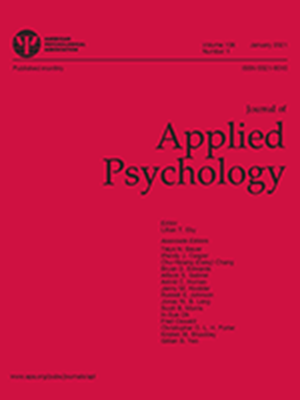培训如何促进工作场所的安全?检验安全培训效果的荟萃分析。
IF 6.1
1区 心理学
Q1 MANAGEMENT
引用次数: 0
摘要
虽然工作场所的安全问题通常通过员工安全培训来解决,但组织研究尚未对安全培训对结果的影响程度进行批判性检查。本荟萃分析考察了各行业的培训文献,以评估安全培训对工作场所安全的前因和指标的影响。我们从157个独立研究中提取了666个影响,并对安全培训的内容(技术或非技术专业知识)、采用的激励策略(促进或预防重点)和干预的利益相关者(员工/内部利益相关者或外部利益相关者的安全)进行了编码。研究结果表明,安全培训对培训结果具有总体正向影响(δ = 0.78),对受训者反应(δ = 0.92)、学习(δ = 1.18)和迁移(δ = 0.61)具有中等到较大的影响,对整体安全指标(δ = 0.26)的影响较小,包括组织安全(δ = 0.20)和个人健康和福祉(δ = 0.15)。研究结果表明,技术和非技术培训,以及以促进和预防为重点的培训,都通过不同的机制有助于提高安全性。此外,与以员工安全为基础的培训相比,以提高外部利益相关者的安全为重点的培训的效应值似乎普遍较弱。我们提供了一个安全培训有效性的综合框架,并为未来的研究提供了建议,以扩展工作场所安全和安全培训的理论。(PsycInfo Database Record (c) 2025 APA,版权所有)。本文章由计算机程序翻译,如有差异,请以英文原文为准。
How does training contribute to workplace safety? A meta-analysis examining the effects of safety training.
Although workplace safety concerns are often addressed with employee safety training, organizational research has yet to provide a critical examination into the extent to which safety training impacts outcomes. This meta-analysis examines the training literature across industries to evaluate the effects of safety training on the antecedents and indicators of workplace safety. We extracted 666 effects from 157 independent studies and coded for the content of safety training (technical or nontechnical expertise), the motivational strategy employed (promotive or preventive focus), and the stakeholder of the intervention (employees/internal stakeholder or external stakeholder safety). Findings suggest that safety training has an overall positive effect on training outcomes (δ = 0.78), demonstrating medium-to-large effects on trainee reactions (δ = 0.92), learning (δ = 1.18), and transfer (δ = 0.61) and smaller effects on overall safety indicators (δ = 0.26), including organizational safety (δ = 0.20) and individual health and well-being outcomes (δ = 0.15). Findings suggest that both technical and nontechnical training, as well as promotion- and prevention-focused training, contribute to improved safety via different mechanisms. Moreover, effect sizes appear generally weaker for training that is focused on improving the safety of external stakeholders compared to employee safety-based programs. We contribute an integrative framework for safety training effectiveness and offer recommendations for future research to extend theory on workplace safety and safety training. (PsycInfo Database Record (c) 2025 APA, all rights reserved).
求助全文
通过发布文献求助,成功后即可免费获取论文全文。
去求助
来源期刊

Journal of Applied Psychology
Multiple-
CiteScore
17.60
自引率
6.10%
发文量
175
期刊介绍:
The Journal of Applied Psychology® focuses on publishing original investigations that contribute new knowledge and understanding to fields of applied psychology (excluding clinical and applied experimental or human factors, which are better suited for other APA journals). The journal primarily considers empirical and theoretical investigations that enhance understanding of cognitive, motivational, affective, and behavioral psychological phenomena in work and organizational settings. These phenomena can occur at individual, group, organizational, or cultural levels, and in various work settings such as business, education, training, health, service, government, or military institutions. The journal welcomes submissions from both public and private sector organizations, for-profit or nonprofit. It publishes several types of articles, including:
1.Rigorously conducted empirical investigations that expand conceptual understanding (original investigations or meta-analyses).
2.Theory development articles and integrative conceptual reviews that synthesize literature and generate new theories on psychological phenomena to stimulate novel research.
3.Rigorously conducted qualitative research on phenomena that are challenging to capture with quantitative methods or require inductive theory building.
 求助内容:
求助内容: 应助结果提醒方式:
应助结果提醒方式:


